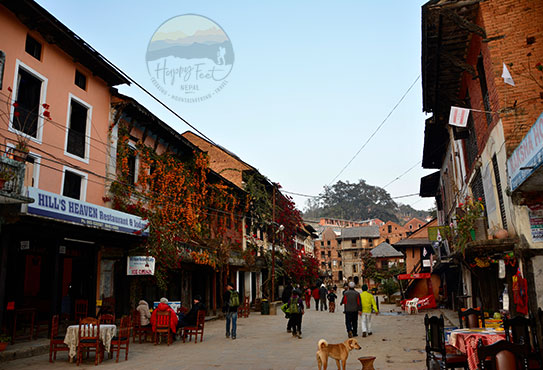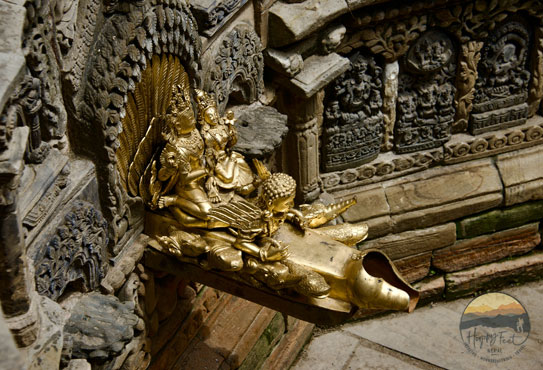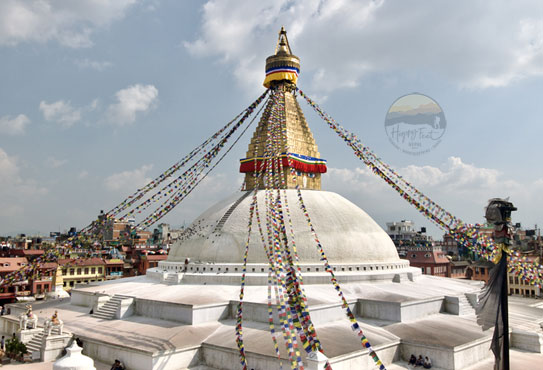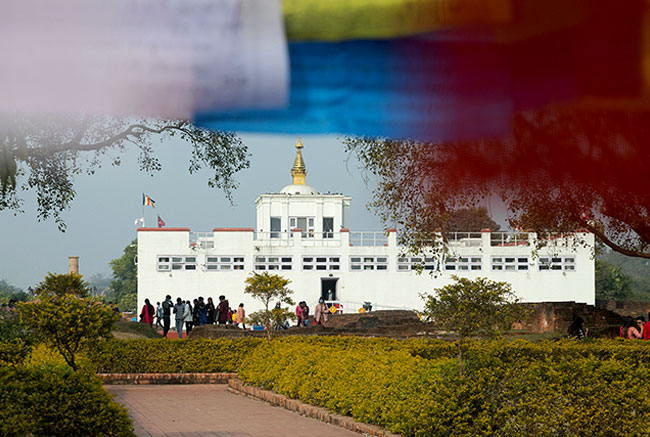-
Sunday - Friday: 9 AM - 4 PM
Kathmandu, Pokhara and Safari – the medieval villages, mountains and safari
The best of Nepal Tour
Kathmandu, Pokhara, and Safari: The best of Nepal tours. Discover the cultural significance of Kathmandu and the monuments surrounding the Kathmandu Valley, which are listed as World Heritage Sites by UNESCO. Then, visit Pokhara, in front of the Annapurna massif, and the Chitwan National Park, one of Asia’s most important natural parks.
Join our short, nine-day, insightful journey through the cultural heritage and stunning natural landscapes of Nepal, curated by Happy Feet Mountaineers. The tour covers the Kathmandu Valley, Nagarkot, Pokhara and Chitwan National Park. Your journey in Nepal begins with your arrival in Kathmandu, a vibrant city where ancient myths and vibrant city life create an inspiring atmosphere for anyone. In the three ancient cities of the Kathmandu Valley, explore historical sites such as Swayambhunath, Boudhanath and Pashupatinath, as well as historic royal squares of Patan, Kathmandu and Bhaktapur, which will awaken your curiosity and appreciation for the unique culture of Nepal.
The trip beautifully combines spiritual discoveries with awe-inspiring scenery. Experience the Hindu rituals at Pashupatinath Temple and the peaceful majesty of Boudhanath Stupa. Ascend to Nagarkot for breathtaking Himalayan sunrises, inspiring a sense of wonder before heading to Pokhara to enjoy grand panoramic views of the Annapurna range from the World Peace Stupa and learn Himalayan insights at the International Mountain Museum.
The final part of the trip includes an exciting Elephant and Jeep safari in Chitwan National Park, one of Asia’s top wildlife reserves, recognised by UNESCO as a World Heritage Site. The trip also includes jungle excursions, boat rides, and exploring Tharu culture, providing a diverse and unforgettable conclusion to your insightful journey to Nepal.
Arrive in Kathmandu, clear customs and immigration formalities, and claim your baggage, which takes some time. Upon arrival, receive a traditional welcome from a Happy Feet Mountaineers representative, then transfer to the hotel. Arrive at the hotel, and the rest of the day is free, with optional excursions (not included), or you can ask to organize any of the tours or stroll through its vibrant streets.
Kathmandu, the capital and heart of the country, is home to three medieval cities that symbolize everything in Nepal. Having lived through several Buddhist and Hindu ruling dynasties, the culture and society of Kathmandu Valley have evolved to give it more than just a unique feature. Today, it is an urban city, still rapidly growing, with its ancient myths and testimony to the greatness of the people who have lived there for time immemorial.
Breakfast at the hotel. In the morning, visit Swayambhunath, located on a lovely little hill to the northwest of the city centre, which is the most sacred Buddhist site. The self-originated shrine is believed to have been built in its current form around 250 B.C. The stupa, painted with a pair of the Buddha’s all-seeing eyes, stands on a lotus mandala base on all four sides. The site offers a complete view of Kathmandu Valley, its surroundings, and the Himalayas to the northeast.
In continuation, drive to Patan, one of the three medieval cities of Kathmandu valley and one of the World Heritage sites among the seven World Heritage sites of Kathmandu valley, located 7 kilometres south-west of Kathmandu. The city of Lalitpur, the City of Arts, was a renowned Buddhist centre in Asia, with four Ashok-built stupas and a multitude of miniature stupas, monasteries, viharas, and temples. At Patan, we visit its Durbar Square, the Golden Temple, Thousand Buddha, and its museum, among other sites, which explain Buddhism and Hinduism in extensive labels within the living traditions and context.
In the evening, visit Durbar Square in Kathmandu, an example of the urban architecture of the Malla dynasty, with 19-storey buildings, temples and palaces, and the residence of the living goddess Kumari. Kathmandu Durbar Square, the old palace complex that houses a mass of temples and palaces, including the Gaddi Baithak Durbar, constructed in 1908; the Basantapur Durbar, or the old Royal Palace; and the Kumari Chowk, the residence of the Living Goddess. Basantapur is amongst the most attractive sites in the bustling centre of Kathmandu, and a western traveller around two hundred years ago wrote that there were more temples than houses and idols than people in its city. Lying at the heart of Kathmandu, Durbar Square is a UNESCO World Heritage Site and a must-see. The individual buildings, palaces, and temples feature intricately carved doors, lattice windows, and struts adorned with mythic and erotic figures.
Finalise with a tour and a rickshaw ride through the old city market centre, the Ason Bazaar, seeing what the Nepalese people buy and sell in their daily lives.
Breakfast at the hotel and drive to Pashupatinath Temple. A pagoda Hindu temple with gilt roofs, carved with silver doors dedicated to Lord Shiva, situated at the bank of the holy Bagmati River, and regarded as among the most sacred temples of the Hindu religion, Pashupatinath is the focus of pilgrimages culminating on the day of Shiva Ratri (the marriage anniversary of Lord Shiva and the goddess Parvati). Pashupati is also the cremation ground in the ghats (cremation group) along the bank of the River Bagmati, where the recently deceased Hindus of the Valley are cremated.
Then visit the Boudhanath, the largest Buddhist shrine in the Kathmandu Valley. This ancient Chorten was built in the 5th century A.D. by King Manadeva. A series of three terraces leads up through water, fire and air segments to the pinnacle, symbolic of space and the highest spiritual attainment. The whole is surrounded by a circle of shops which form a small Tibet. Lord Buddha’s four pairs of eyes flash vividly in the cardinal directions, radiating the message of Mahayana Buddhism, known as Lamaism in Sikkim, Ladakh, Bhutan and Tibet.
In the afternoon, take a 13-kilometre drive to Bhaktapur, east of Kathmandu. Its original name is Bhadgaon, or the village of Devotees, which is one of the living museums of Kathmandu Valley. Bhaktapur is filled with the 55-windowed Royal Palace, the Palace of the Kumari, the temple of Taleju, the temple of Pashupati, the main square of Taumadhi Tole, Nyatapola Temple (the most imposing and tallest such architecture in all of Nepal), the temple of Akash Bhairab (the second most important temple of Bhadgaon), the Dha Hateya and the Square of the Potters. UNESCO recognises Bhaktapur as a World Heritage Site.
After the visit, drive to Nagarkot, located at an altitude of 2,100m and 32 kilometres east of Kathmandu or 19 kilometres northeast of Bhaktapur. Nagarkot is one of the most beautiful hill resort areas to enjoy sunrises and Mountain Range views, from the Langtang to Everest.
210km – 6hrs drive.
Sunrise view tour. Breakfast at the hotel and departure by road to Pokhara, located 200 kilometres west of Kathmandu, is the third-largest city in the country. Due to its location, the temperature is always warmer than in Kathmandu. The driving takes you through an exciting highway of the country overlooking mountains and hills and scattered villages until we reach Pokhara. The Annapurna Mountains, Machhapuchhre Himal, and Lamjung Mountains rim the northeastern horizons of the town.
Breakfast at the hotel and transfer 13-kilometres to Pumdikot, a strategic hill with an ancient fort in ruins and recently converted into a Shiva temple; it is a beautiful viewpoint. The views of Annapurna, Pokhara and the peace stupa are beyond description. From Pumdikot, we take a scenic drive to Peace Stupa, enjoying magnificent views of Phewa Lake, the Himalayas, Pokhara City and its surroundings. The Peace Stupa site is equally beautiful, with splendid views.
The World Peace Stupa stands gloriously on a hill saddle above Phewa Lake and Pokhara City from where you get panoramic views of Phewa Lake, the city of Pokhara and Mount Annapurna and Lamjung (on a clear day). A Peace Stupa is a Buddhist monument to inspire peace in all races and creeds and to help unite them in their quest for world peace. Most of them were built since World War II under the direction of Nichidatsu Fujii (1885-1985), a Buddhist monk from Japan and founder of the Nipponzan-Myohoji Buddhist Order. In 1947, he started the construction of peace pagodas as world peace shrines, and in the year 2000, there were eighty Peace Pagodas built around the world between Europe, Asia and the United States.
Enjoy the landscapes of the site, visit the stupa, explore, go down to the lake shore, cross the lake by little boat, have a late lunch and visit the International Mountain Museum in Pokhara, where we will see and better understand the history of the mountain and mountaineering on the highest peaks in the world. We will understand the importance of the Himalayas of Nepal and the benefits that the Himalayas give to the millions of people and their natural habitat. After the visit, return to the shore of the lake for free time.
165km -5hrs drive.
Early in the dawn, sunrise view tour to Sarangkot viewpoint. Sarangkot, the most famous lookout in Pokhara, offers a grand panorama of the Annapurna ranges, Machhapuchare, Manaslu, LamjungHimal, and Dhaulagiri ranges. From the Sarangkot lookout, you can also see the beautiful view of Pokhara Valley and its unique landscapes with Lake Phewa, Lake Begnas and Lake Rupa. A short 25-minute drive from the hotel in Pokhara lakeside puts you on Sarangkot, which offers a striking view of sunrise and a platform for Paragliding. Finalise the tour and drive back to the hotel for breakfast.
Then continue the drive to Chitwan National Park for a two-night and three-day safari program. Chitwan is the best national park in Asia, with an area of 967 km and 200km south of Kathmandu in the Terai floodplain formed by the Narayani and Rapti rivers system. This park is well known for its wildlife preservation. Arrive at to resort and check in, and have lunch. In the afternoon, visit the Tharu Village and sunset view tour. At night Tharu Culture Show. Dinner and accommodation at the Barahi Jungle Lodge, a 4-star resort (full board).
Full day in the park with different activities such as a Jungle safari on the elephant back exploring the fauna and flora, highlighting the one-horned rhinoceros, deer, monkeys, wild boars, bison, bears, leopards and hopefully the Bengal tiger. In this area, there are 276 species of birds out of a total of 519, which makes it a true paradise for bird watchers. We will also do a canoe excursion on the Rapti River and visit the elephant area—lunch at the resort. In the afternoon the guides will take you on a nature walk—dinner and accommodation at the Barahi Jungle Lodge, a 4-star resort (full board).
180km -6hrs drive.
Early morning nature walking—breakfast at the resort and departure by road to Kathmandu. Sightseeing driving takes you through the plains of Terai and ascends slowly to the hill and then into the valley of Kathmandu. Finally, arrive and transfer to the hotel. The rest of the day remains for leisure on your own.
Breakfast and the rest of the day are leisure on your own. The representative of Happy Feet Nepal will arrive at your hotel with transport three hours before your departure flight time. Get escorted from the hotel to the International Departure Terminal, see off formalities, and go through the immigration and departure.
Sarankot Hill
Sarangkot, the most famous lookout in Pokhara, offers a grand panorama of the Annapurna ranges, Machhapuchare, Manaslu, Lamjung Himal, and Dhaulagiri range. From the Sarangkot lookout, you can also see the beautiful view of Pokhara Valley and its unique landscapes with Lake Phewa, Lake Begnas and Lake Rupa. A short 25-minute drive from the hotel in Pokhara lakeside puts you on Sarangkot, which offers a striking view of sunrise and a platform for Paragliding.
Phewa Lake
Phewa Lake is the largest lake in Pokhara, which attracts many visitors and offers water activities and is a natural jewel to the city. If you take boating on the lake, you can enjoy the reflection of the fishtail and Annapurna Mountains all day and a beautiful sunset colour in the evening. A small island
The Island is in the lake’s centre and has a two-storied pagoda temple dedicated to the Ajima, the protector deity in Buddhist and Hindu, representing female Shakti (power). The southwestern shorelines are densely protected jungles known as Rani Ban (Queen Forest), a lovely sanctuary for birdlife. Other major lakes in Pokhara are Begnas Tal and Rupa Tal, situated to the northeast of the city, within an hour’s driving distance.
Seti Gorge
Seti Gorge is offered as a site to see in Pokhara. Seti Gorge is the section cut by the river Seti to a deep underground; at places hides the entire river and, in some areas, two meters in width and 20 to 50 metres in depth. There are two sites to see the depth of Seti Gorge; one just from the centre of the local bazaar at Mahendra Pul (bridge) and another just a little further at KI Sing Pul (bridge) with a park and garden. The parts are wild and fragile, and strictly suggested not to try to see them.
David’s Fall
Another attraction of Pokhara is the beautiful cascading waterfalls popularly known as Devi’s Fall, locally called Patale Chhango, another attraction of Pokhara, two kilometres southwest of the city. David’s Fall is named after a person with the same name who fell underground in the water. The site is attractive in the summertime when the tremendous amount of water from Phewa Lake falls underground,
Caves of Pokhara
There are two main caves for exploring. First, the Mahindra Gufa (cave), locally known as Bats Cave, is 45 minute drive north of Pokhara. A (torch/flashlights recommended while visiting caves) enter for some time and view the large limestone, stalactites and stalagmites, and the bats.
Another cave is Gufteswor Gufa, just walking distance from Devis’ Fall across the street. The entrance is wide with artificial steps and a later-built Shiva shrine. One can go further down to view the raging Seti River entering a channel into the cave.
The Old Bazaar
The old city of Pokhara is a beautiful site to visit. The houses and temples in this part of the city reflect the Newari architecture of Kathmandu Valley, as some Newari communities from Kathmandu moved to Pokhara for trading. The local bazaar has Bindhayabasini Mandir (temple); this white dome-shaped temple dominates a spacious stone-paved courtyard on a shady hilltop with excellent views of the local bazaar and Annapurna Mountains.
Pokhara Peace Stupa
Peace stupa is another excellent viewpoint in Pokhara. Twenty minutes of boating and 45 minutes of beautiful hike or a drive to reach the Shanti or Peace Stupa, located south of Phewa Lake on a ridge top.
Peace / Shanti Stupa, a Buddhist pagoda located on a hilltop, is also known as Ananda Hill; built by a Japanese monk Nipponzan-Myōhōji and Morioka Sonin with local supporters under the guidance of Nichidatsu Fujii, a Buddhist head monk founder of Nipponzan-Myōhōji. Shanti means peace in the Sanskrit language, s scenic hilltop facing super views of Pokhara valley and snowcapped peaks towards the north.
International Mountain Museum
International Mountain Museum, the first of its kind in Pokhara city, was established and built by Nepal Mountaineering Association (NMA) on 1 November 1973. The primary objective of establishing this museum was to record the chronicle of the past and present development of mountaineering activities globally and preserve the saga of the feats in mountaineering history in the Himalayan Peaks. The foundation stone of IMM was laid on 1 December 1995. The soft opening of IMM took place on 29 May 2002 and officially opened on 5 February 2004. The IMM is an exciting place to gather knowledge of the mountains, expeditions, flora and fauna, geography, history of mountaineering in Nepal and more. It is located just near the main local area of Pokhara.
Other activities of great interest:
Besides relaxing tours, Pokhara has various adventure sports activities such as Para Gliding, Zip-Flyer, Boating, Kayaking, white-water rafting, and Ultra-Light flight.





